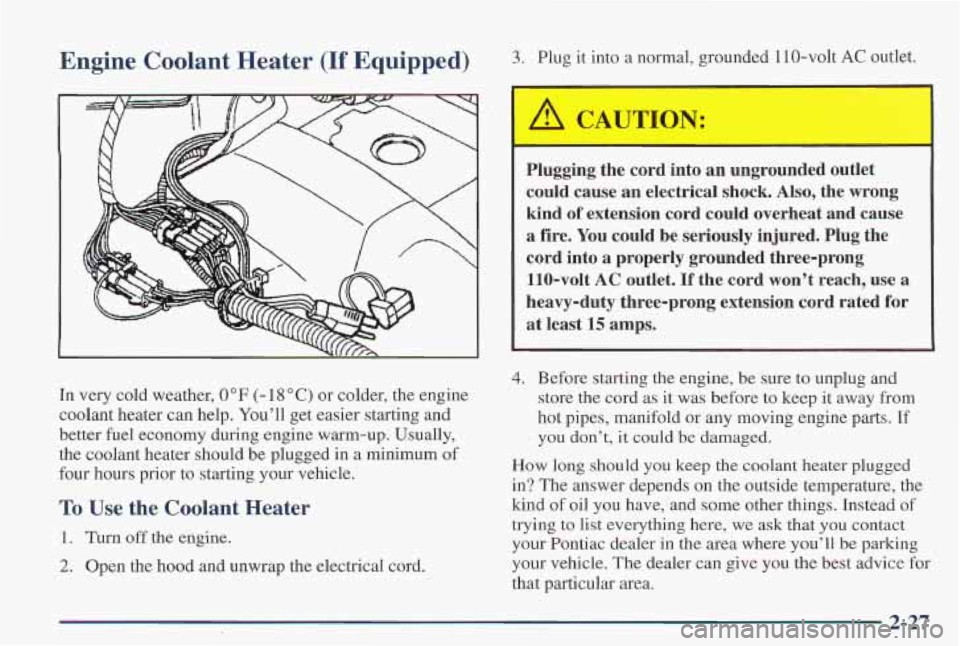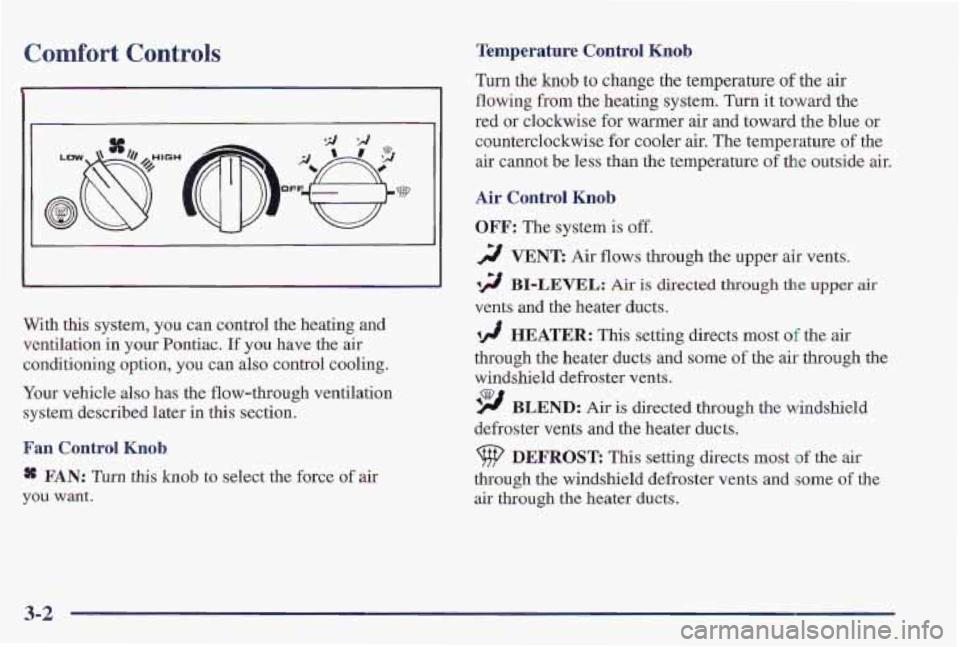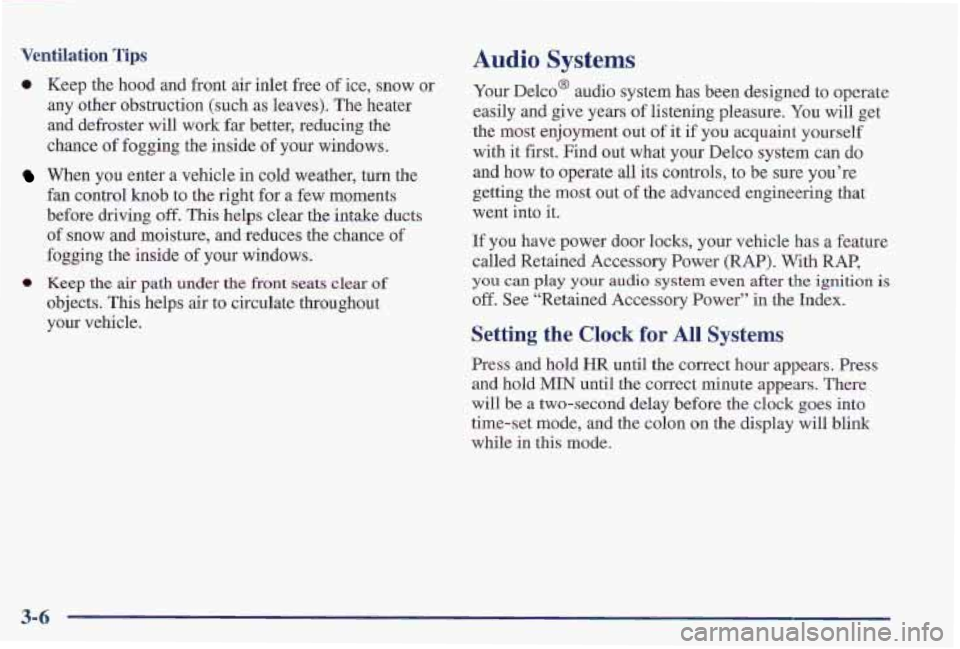heater PONTIAC FIREBIRD 1997 Owners Manual
[x] Cancel search | Manufacturer: PONTIAC, Model Year: 1997, Model line: FIREBIRD, Model: PONTIAC FIREBIRD 1997Pages: 410, PDF Size: 19.2 MB
Page 50 of 410

Section 2 Features and Controls
~~ ~ ~
Here you can learn about the many standard and optional features on your Pontiac, and information on starting,
shifting and braking. Also explained are the instrument panel and the warning systems that tell you if everything is
working properly -- and what to do if you have a problem.
2-2
2-4
2-6
2-
10
2-12
2-13
2-1 6
2- 17
2-23
2-23
2-25
2-27 2-28
2-32
2-37
2-3 8
2-40
Keys
Door Locks
Remote Keyless Entry System
Hatch
Theft
Vehicle and Content Theft-Deterrent System
Feature Customization New Vehicle “Break-In”
Ignition Switch
Starting Your Engine
Engine Coolant Heater
Automatic Transmission Operation
Manual Transmission
Parking Brake
Shifting Into PARK (P)
Parking Your Vehicle
PASS-K@ 11
2-40
2-4 1
2-4
1
2-43
2-43
2-44
2-44
2-5 1
2-54
2-56
2-5
8
2-59
2-60
2-6 1
2-68
2-74
2-77
Shifting Out of PARK (P)
Parking Over Things That Burn
Engine Exhaust
Windows
Horn
Tilt Steering Wheel
Turn SignaVMultifunction Lever
Lamps
Interior Lamps
Mirrors
Storage Compartments
Ashtray and Lighter
Sun Visors
Floor Mats
Convertible
Top
Instrument Panel
Warning Lights,
Cages and Indicators
2-1
Page 76 of 410

Engine Coolant Heater (If Equipped) 3. Plug it into a normal, grounded 110-volt AC outlet.
Plugging the cord into an ungrounded outlet
could cause
an electrical shock. Also, the wrong
kind
of extension cord could overheat and cause
a fire. You could be seriously injured. Plug the
cord into a properly grounded three-prong 110-volt
AC outlet. If the cord won't reach, use a
heavy-duty three-prong extension cord rated for
at least
15 amps.
In very cold weather, 0°F (- 18 "C) or colder, the engine
coolant heater can help. You'll get easier starting and
better fuel economy during engine warm-up. Usually,
the coolant heater should be plugged in
a minimum of
four hours prior to starting your vehicle.
To Use the Coolant Heater
1. Turn off the engine.
2. Open the hood and unwrap the electrical cord.
4. Before starting the engine, be sure to unplug and
store the cord as it was before to keep it away from
hot pipes, manifold or any moving engine parts. If
' you don't, it could be damaged.
How long should you keep the coolant heater plugged
in? The answer depends on the outside temperature, the
kind
of oil you have, and some other things. Instead of
trying to list everything here, we ask that you contact
your Pontiac dealer in the area where you'll be parking
your vehicle. The dealer can give you the best advice
for
that particular area.
2-27
Page 141 of 410

Comfort Controls Temperature Control Knob
Turn the knob to change the temperature of the air
I flowing from the heating system, Turn it toward the
I, ,I red or clockwise for warmer air and toward the blue or
counterclockwise
for cooler air. The temperature of the
air cannot be less than the temperature
of the outside air.
Air ContL - - ____ - .b
OFF: The system is off. I
2 VENT Air flows through the upper air vents.
12 BI-LEVEL: Air is directed through the upper air
vents and the heater ducts.
With this
system, you can control the heating and
ventilation in your Pontiac.
If you have the air
conditioning option, you can also control cooling.
Your vehicle also has the flow-through ventilation
system described later in this section.
Fan Control Knob.
a FAN: Turn this knob to select the force of air
you want.
/ HEATER: This setting directs most of the air
through the heater ducts and some
of the air through the
windshield defroster vents.
'9 BLEND: Air is 'directed through the windshield
defroster vents
and the heater ducts.
9 DEFROS'G: This setting directs most of the air
through the windshield defroster vents and some of the
air through the heater ducts.
3-2
Page 143 of 410

Heating
The heater works best if you keep your windows closed
while using it.
1. Turn the air control knob to HEATER.
2. Turn the fan control knob to the desired speed.
3. Turn the temperature control knob to a
During initial start-up only, if your vehicle is equipped
with
an optional engine coolant h'eater, you can use it in
cold weather (around +20°F/-8"C or lower) to improve
heater performance on start up, Because an engine
coolant heater
warms the engine coolant, your vehicle's
heating
system can more efficiently pro'vide heat for the
passenger area of your vehicle. See "Engine Coolant
Heater" in the Index.
comfortable
setting.
Bi-Level Heating
You may want to use bi-level heating on cool, but sunny
days. This setting directs cool air toward your body and
warmer air toward your feet. 1,
Turn the air control
knob to BI-LEVEL.
2. Turn the temperamre control knob to a
3. Turn the fan control knob to the desired speed.
comfortable
setting.
Ventilation
For mild outside temperatures when little heating or
cooling is needed, you can still direct outside air through
your vehicle.
I, Turn the air control knob to VENT.
2. Turn the temperature control knob to a
3. Turn the fan control knob to the desired speed.
co'mfortable setting.
Defogging and Defrosting
1. 'Turn
the air cantrol knob to DEFROST.
2. Turn the temperature control knob to the
3. Turn the fan control knob to the desired speed.
desired setting.
3-4
Page 145 of 410

Ventilation Tips
a Keep the hood and front air inlet free of ice, snow or
any other obstruction (such
as leaves). The heater
and defroster will work far better, reducing the
chance
of fogging the inside of your windows.
When you enter
a vehicle in cold weather, turn the
fan control
knob to the right for a few moments
before driving
off. This helps clear the intake ducts
of snow and moisture, and reduces the chance of
fogging
the inside of your windows.
Keep the air path under the rront sems clear of
objects. This helps air to circulate throughout
your vehicle.
Audio Systems
Your Delco@ audio system has been designed to operate
easily and give years
of listening pleasure. You will get
the most enjoyment out
of it if you acquaint yourself
with it first. Find out what your Delco system can do
and how to operate all its controls,
to be sure you’re
getting the most out o’f the advanced ‘engineering that
went into it.
If you have power door locks, your vehicle has a feature
called Retained Accessory Power
(RAP). With RAP,
you can play your audio system even after the ignition is
off. See “Retained Accessory Power” in the Index.
Setting the Clock for All Systems
Press and hold HR until the correct hour appears. Press
and hold MIN until the correct minute appears. There
will
be a two-second delay before the clock goes into
time-set mode, and the colon on the display will blink
while
in this mode.
3-6
Page 194 of 410

A CAUTION: ..
Snow can trap exhaust gases under your vehicle.
This can cause deadly CO (carbon monoxide) gas
to get inside.
CO could overcome you and kill
you. You can’t see
it or smell it, so you might not
know it is in your vehicle. Clear away snow from
around the base of your vehicle, especially any
that
is blocking your exhaust pipe. And check
around again from time to time to be sure snow
doesn’t collect there.
Open
a window just a little on the side of the
vehicle
that’s away from the wind. This will help
keep
CO out.
Run your engine only as long as you must. This saves
fuel. When you run the engine, make
it go a little faster
than just idle. That
is, push the accelerator slightly. This
uses less fuel for the heat that you get and it keeps the
battery charged. You will need a well-charged battery to
restart the vehicle, and possibly for signaling later
on
with your headlamps. Let the heater run for awhile.
Then, shut the engine
off and close the window almost
all the way to preserve the heat. Start the engine again
and repeat this only when you feel really uncomfortable
from the cold. But do
it as little as possible. Preserve the
fuel as long as you can. To help keep warm, you can get
out of the vehicle and do some fairly vigorous exercises
every half hour or so until help comes.
4-29
Page 220 of 410

If No Steam Is Coming From Your Engine
If you get the overheat warning but see or hear no
steam, the problem may not be too serious. Sometimes
the engine can get a little too hot when you:
Climb a long hill on a hot day.
Stop after high-speed driving.
Idle for long periods in traffic.
Tow a trailer.
If you get the overheat warning with no sign of steam,
try this for a minute or
so:
1. If you have an air conditioner, turn it off.
2. Turn on your heater to full hot at the highest fan
speed and open the window as necessary.
3. If you’re in a traffic jam, shift to NEUTRAL (N);
otherwise, shift to the highest gear while
driving
-- AUTOMATIC OVERDRIVE (@) or
DRIVE (D) for automatic transmissions.
If you no longer have the overheat warning, you can
drive. Just to be safe, drive slower for about
10 minutes.
If the warning doesn’t come back on, you can
drive normally.
If the warning continues, pull over, stop, and park your
vehicle right away.
If there’s still no sign of steam, you can idle the engine
for two or three minutes while you’re parked, to see if
the warning stops. But then, if
you still have the
warning,
turn ofSthe engine and get everyone out of the
vehicle until it cools down.
You may decide not to lift the hood but to get service
help right away.
When you decide it’s safe to lift the hood, here’s what
you’ll see:
Page 221 of 410

..
A. Cool - ~ : Zecovery Tank
B. Radiator Pressure Cap
C. Electric Engine Fan
I /A CAUTION:
An electric fan under the hood can start up even
when the engine is not running and can injure
you. Keep hands, clothing
and tools away from
any underhood electric fan.
If the coolant inside th'e coolant recovery tank is boiling,
don't
do anything else until it cools down.
When it is cool, remove the coolant recovery tank cap
and look at the dipstick.
The coolant l'evel should be at
FULL COLD.
If it isn't, you may have a leak in the radiator hoses,
heater hoses, radiator, water pump or somewhere else in
the cooling system.
5-16
Page 222 of 410

Heater and radiator hoses, and other engine
parts, can be very hot. Don’t touch them.
If you
do, you can be burned.
Don’t run the engine if there is a leak.
If you run
the engine,
it could lose all coolant. That could
cause an engine fire, and you could be burned.
Get any leak fixed before you drive the vehicle.
NOTICE:
Engine damage from running your engine
without coolant isn’t covered
by your warranty.
If there seems to be no leak, with the engine on, check to
see if the electric engine fans are running. If the engine
is overheating, both fans should be running. If they
aren’t, your vehicle needs service.
How to Add Coolant to the Coolant
Recovery Tank
If you haven’t found a problem yet, but the coolant level
isn’t at
FULL COLD add a 50/50 mixture of clean water
(preferably distilled) and DEX-COOL@ (silicate-free)
antifreeze at the coolant recovery tank. (See “Engine,
Coolant’’
in the Index for more information.)
Adding only plain water to your cooling system
can be dangerous. Plain water,
or some other
liquid like alcohol, can boil before the proper
coolant mix will. Your vehicle’s coolant warning
system is set for the proper coolant mix. With
plain
water or the wrong mix, your engine could
get too hot but you wouldn’t get the overheat
warning. Your engine could catch fire and you
or
others could be burned. Use a 50/50 mix of clean
water and DEX-COOL@coolant.
5-17
Page 223 of 410

NOTICE:
In cold weather, water can freeze and crack the
engine, radiator, heater core
and other parts.
Use the recommended coolant and the proper
coolant
mix.
You can be burned if you spill coolant on hot
engine parts. Coolant contains ethylene
glycol
and it will burn if the engine parts are hot
enough. Don’t spill coolant on a hot engine. 1
When the coolant in the coolant recovery tank is at
FULL COLD start your vehicle.
If the overheat warning continues, there’s one more
thing you can try. You can add the proper coolant mix
directly to
the radiator but be sure the cooling system is
cool before you do it.
~
1 A CAUTION:
Steam and sc’alding liquids from a hot cooling
system can
blow out and burn you badly. They
are under pressure, and
if you turn the pressure
cap
-- even a little I- they can come out at high
speed. Never turn the cap when the cooling
system, including the pressure cap, is hot. Wait
for the cooling system and pressure cap to
cool if
you ever have to turn the pressure cap.
5-18